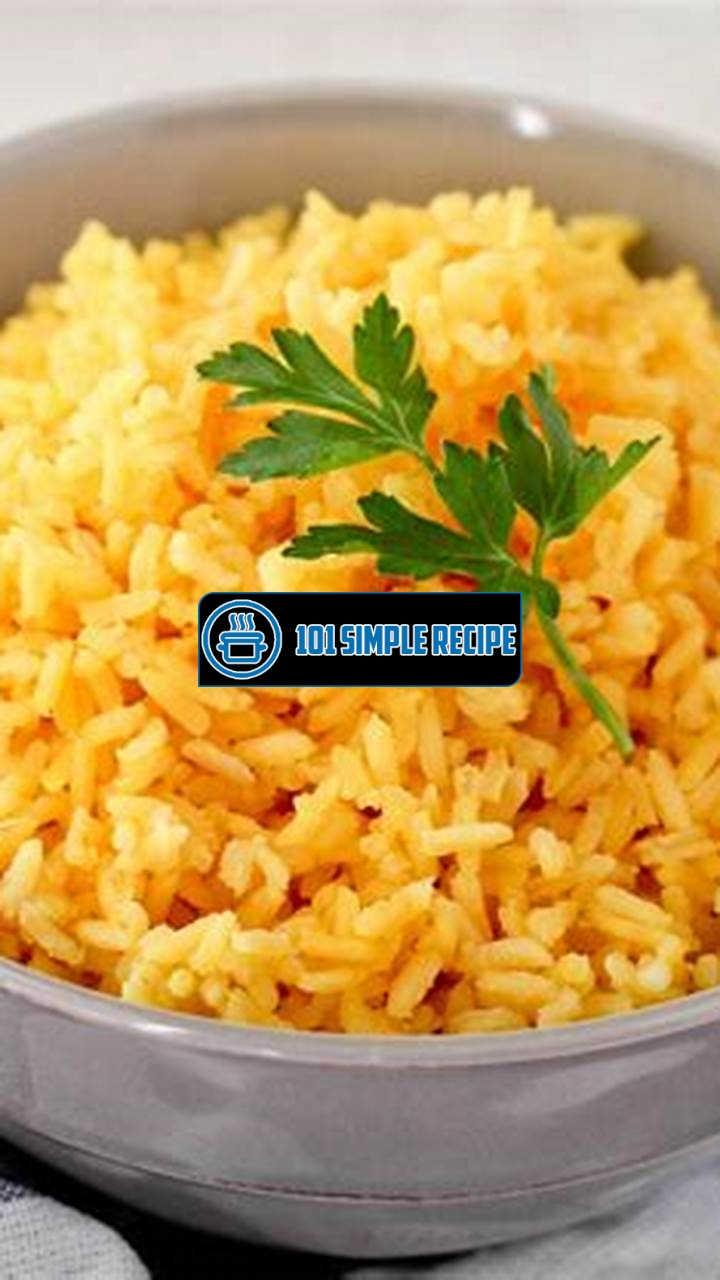Looking to create a delicious batch of homemade yellow rice? Look no further! In this article, we will guide you through the best way to make yellow rice in the comfort of your own kitchen. With our step-by-step instructions and helpful tips, you’ll be able to achieve a vibrant and flavorful dish that will impress your family and friends. So, let’s dive in and discover the secrets to perfecting this beloved rice dish!

Understanding Yellow Rice
Yellow rice is a beloved and versatile dish that has its origins in various cultures around the world. This flavorful rice dish gets its vibrant yellow color from the addition of spices such as turmeric or saffron. People all over the globe enjoy yellow rice for its delicious taste and beautiful presentation. In this article, we will delve into the origins and cultural significance of yellow rice, as well as explore its traditional ingredients and various mouth-watering variations.
The History of Yellow Rice
The history of yellow rice dates back centuries and is deeply rooted in the culinary traditions of multiple cultures. One of the earliest known examples of yellow rice can be traced back to the Moorish presence in Spain during the medieval period. The Moors introduced saffron-infused rice to the Iberian Peninsula, and it quickly became a staple in Spanish cuisine.
Furthermore, yellow rice is also prevalent in various Asian cuisines. In India, turmeric-cooked rice known as “haldi chawal” is a common fixture during festive occasions and weddings. In Indonesia, the iconic “nasi kuning” is served during special events and celebrations.
Across Latin America, yellow rice is referred to as “arroz amarillo” and holds cultural importance. It is often served with traditional dishes like Cuban ropa vieja, Puerto Rican pernil, or Colombian bandeja paisa. The dish’s versatility and rich flavor have made it a beloved side dish or main course in many Latin American households.
Traditional Ingredients in Yellow Rice
The traditional ingredients used in yellow rice differ depending on the cultural context. However, some key components remain consistent. Rice, of course, is the foundation of this dish. It is typically long-grain rice that is used, which gives the dish a fluffy texture.
Another essential ingredient is the spice that imparts the yellow color. In some recipes, saffron threads are used, providing a fragrant and slightly floral note. Alternatively, turmeric, a vibrant yellow spice, is often used as a cost-effective substitute for saffron.
To add depth of flavor, aromatics such as onions, garlic, and bell peppers are sautéed before adding the rice. This step helps to infuse the rice with a flavorful base. Lastly, various herbs and spices, such as cumin, coriander, or bay leaves, are added to enhance the overall taste profile of the dish.
Variations of Yellow Rice
Yellow rice is a versatile dish that adapts well to regional variations and personal preferences. Different cultures have put their own spin on this classic recipe, resulting in numerous delicious variations.
In the Caribbean, for example, one popular variation is “arroz con gandules” which incorporates pigeon peas and pork into the yellow rice. In Thai cuisine, “khao mok gai” is a delightful dish where yellow rice is layered with fragrant spiced chicken.
Vegetarian and vegan options are also abundant. By substituting meat or seafood with vegetables or plant-based proteins, you can create a nutritious and flavorful yellow rice dish that suits your dietary needs.
Ultimately, the beauty of yellow rice lies in its versatility, ability to adapt to different culinary traditions, and the joy it brings to those who taste it. Whether you enjoy it as a comforting side dish or a standout main course, yellow rice is sure to please your senses and transport you to a world of vibrant flavors.
Choosing the Right Rice
When it comes to making the best yellow rice at home, choosing the right type of rice is essential. Different varieties of rice have different textures and flavors, so it’s important to select the one that will complement your yellow rice recipe perfectly. In this section, we’ll explore the different types of rice and help you determine which variety is best suited for making yellow rice.
Long Grain vs. Short Grain Rice
Long grain rice and short grain rice are the two main categories of rice. Each variety has its own unique characteristics that can significantly impact the final result of your yellow rice.
- Long grain rice: This type of rice has long, slender grains that stay separate and fluffy when cooked. It is ideal for making yellow rice with distinct grains that don’t clump together. Long grain rice is also known for its slightly nutty flavor.
- Short grain rice: Short grain rice, on the other hand, has shorter and plumper grains that tend to stick together when cooked. It is perfect for creating a creamier and stickier texture in your yellow rice. Short grain rice often has a slightly sweeter taste compared to long grain rice.
Depending on your preference for texture and taste, you can choose between long grain rice and short grain rice to achieve the desired outcome for your yellow rice recipe.
Basmati vs. Jasmine Rice
Within the long grain rice category, there are specific varieties that are popular for making yellow rice. Basmati rice and Jasmine rice are two such varieties known for their aromatic qualities.
- Basmati rice: Basmati rice is a long grain rice that originates from the Indian subcontinent. It has a distinct aroma and delicate flavor that complements the spices and seasonings typically used in yellow rice recipes. Basmati rice has long, slender grains that cook up fluffy and separate.
- Jasmine rice: Jasmine rice, commonly used in Southeast Asian cuisine, is another fragrant long grain rice choice for yellow rice. It has a subtle floral aroma and a slightly sticky texture when cooked. The fragrance of Jasmine rice enhances the overall taste and aroma of your yellow rice dish.
Both Basmati and Jasmine rice can add an extra layer of flavor and aroma to your yellow rice, making them excellent options to consider when selecting the right rice variety.
Parboiled vs. Regular Rice
Parboiled rice and regular rice are two different processing methods that affect the texture and cooking properties of the rice.
- Parboiled rice: Parboiled rice undergoes a unique processing method where the rice is partially cooked in its husk before being milled. This process helps retain more nutrients in the rice grain. When it comes to making yellow rice, parboiled rice holds up well and maintains its texture, resulting in grains that don’t break easily.
- Regular rice: Regular rice, also known as white rice, is the most common type of rice found in households. It goes through a milling process that removes the hull and bran, resulting in a whiter appearance. Regular rice tends to be softer and stickier when cooked, which can contribute to a creamier texture in your yellow rice.
Whether you choose parboiled rice or regular rice for your yellow rice recipe depends on your preference for texture and the desired level of nutrient retention.
Note: Experimenting with different rice varieties and processing methods can help you discover your personal favorite when it comes to making the best yellow rice at home. Don’t be afraid to try different combinations to find the perfect match for your taste buds.
By understanding the differences between long grain and short grain rice, as well as the nuances of Basmati and Jasmine rice, alongside the distinctions between parboiled and regular rice, you can confidently select the best rice variety for your yellow rice recipe. Remember, choosing the right rice is the foundation for creating a flavorful and satisfying dish that will impress your family and friends!
Enhancing the Flavor
When it comes to making the best yellow rice at home, enhancing the flavor is key. By using various spices and ingredients, you can elevate your yellow rice recipe to the next level. Whether you’re looking to add a burst of aromatic spices or incorporate vegetables and protein, these tips will help you create a truly delicious dish.
Saffron: The Essential Ingredient
One essential ingredient for making yellow rice is saffron. Known for its vibrant color and unique flavor, saffron adds a special touch to any rice dish. To incorporate saffron into your yellow rice recipe, start by soaking a few threads of saffron in warm water. This will help release its color and aroma. Then, simply add the saffron-infused water to your rice as it cooks. The result will be a beautifully colored and aromatic dish that is sure to impress.
Other Aromatic Spices for Yellow Rice
In addition to saffron, there are a variety of other aromatic spices that can enhance the flavor of your yellow rice. One popular option is turmeric, which not only adds a vibrant yellow color to the rice but also offers a warm and earthy flavor. Other spices to consider include cumin, coriander, and cinnamon. These spices can be added to the rice as it cooks, allowing their flavors to infuse into each grain.
Adding Vegetables and Protein
For a more substantial and nutritious yellow rice dish, consider adding vegetables and protein. This not only adds variety to your meal but also increases its nutritional value. One option is to add diced bell peppers, onions, and peas to the rice. This will not only add a pop of color but also provide added texture and flavor. Additionally, you can add protein such as chicken, shrimp, or tofu. These options can be cooked separately and then added to the rice during the final stages of cooking. This allows the flavors to meld together and create a well-rounded dish.
By exploring various spices and ingredients, such as saffron, turmeric, and vegetables, you can enhance the flavor of your yellow rice recipe. These additions not only add depth and complexity but also create a visually appealing dish. So why wait? Start experimenting with flavors and enjoy the best yellow rice at home today!
Cooking Techniques for Perfect Yellow Rice
When it comes to making yellow rice at home, there are a few cooking techniques that can help you achieve perfectly cooked and fluffy results every time. Whether you’re a seasoned chef or a novice in the kitchen, these tips and tricks will ensure that your yellow rice turns out delicious and fragrant.
The Rice-to-Water Ratio
The first key to cooking perfect yellow rice is getting the rice-to-water ratio right. This is crucial to ensure that your rice is neither too mushy nor too dry. For the best results, use a ratio of 1 cup of rice to 1 ½ cups of water. This will give you fluffy and separate grains of rice that are full of flavor.
Note: To add a bit of extra flavor to your yellow rice, you can substitute some of the water with chicken or vegetable broth. This will infuse the rice with a savory taste that complements the spices and turmeric.
Methods of Cooking Yellow Rice
There are several methods you can use to cook yellow rice, but the most common ones are the stovetop method and the rice cooker method.
Stovetop Method:
The stovetop method involves cooking the rice in a pot on the stove. To begin, rinse the rice under cold water to remove any excess starch. Then, add the rice and water to a pot and bring it to a boil. Once it’s boiling, reduce the heat to low and cover the pot with a tight-fitting lid. Let the rice simmer for about 15-20 minutes, or until the liquid is absorbed and the rice is tender. Fluff the rice with a fork before serving.
Rice Cooker Method:
If you have a rice cooker, making yellow rice will be a breeze. Simply rinse the rice and add it to the rice cooker along with the water or broth. Close the lid and press the cook button. Once the rice is cooked, let it sit for a few minutes to steam before fluffing with a fork.
Preventing Stickiness and Clumping
One common problem when cooking yellow rice is it becoming sticky and clumpy. To avoid this, make sure you follow these simple steps:
- Rinse the rice before cooking to remove excess starch.
- Use the correct rice-to-water ratio to ensure the rice cooks evenly.
- Avoid stirring the rice while it’s cooking as this can cause it to become sticky.
- After the rice is cooked, let it sit for a few minutes before fluffing with a fork. This will allow any excess moisture to evaporate, resulting in perfectly cooked and fluffy rice.
By following these techniques and tips, you’ll be able to make the best yellow rice at home. Whether you’re serving it as a side dish or incorporating it into a main course, your perfectly cooked and fluffy yellow rice will be a hit with family and friends.
Serving and Pairing Yellow Rice
Yellow rice is a versatile and flavorful dish that can be served in various ways. Whether you are looking to complement its flavors or create a unique culinary experience, there are plenty of options to explore. Here, we will discuss the best ways to serve yellow rice and delicious dishes that pair perfectly with it.
Popular Accompaniments for Yellow Rice
When it comes to serving yellow rice, there are a few popular accompaniments that can enhance its taste and presentation.
- Add a protein: Yellow rice goes well with protein-rich dishes such as grilled chicken, beef, or shrimp. The combination of the tender meat and vibrant yellow rice creates a satisfying meal.
- Include vegetables: Incorporating colorful vegetables not only adds visual appeal but also provides a healthy boost to your yellow rice. You can sauté bell peppers, corn, peas, or carrots and mix them into your rice for a nutritious and flavorful side dish.
- Pair with beans: Beans are a staple in many cuisines and can be a great addition to yellow rice. Whether you choose black beans, kidney beans, or chickpeas, they add a delightful texture and taste to the dish.
These popular accompaniments provide a balanced and satisfying meal that perfectly complements the flavors of yellow rice.
Yellow Rice in International Cuisine
Yellow rice is not only a popular dish in many cultures but also has variations that are unique to each cuisine.
In Latin American cuisine, yellow rice, also known as “arroz amarillo,” is often served alongside dishes like braised meats, grilled seafood, or stews. The vibrant yellow color comes from the use of saffron or turmeric, adding a distinct flavor and aroma.
In Indian cuisine, yellow rice, also known as “pulao” or “pilaf,” is a fragrant and flavorful dish. It is commonly prepared with spices such as cumin, cloves, and cardamom, giving it a rich and aromatic taste. Yellow rice in Indian cuisine is typically served with curries, roasted meats, or vegetable dishes.
Exploring yellow rice in different international cuisines allows you to experience the diverse flavors and culinary traditions associated with this delightful dish.
Creative Recipes with Leftover Yellow Rice
Got some yellow rice leftover from the previous day? Don’t let it go to waste! There are plenty of creative recipes you can try using leftover yellow rice.
One idea is to make yellow rice fritters by combining the leftover rice with some beaten eggs, flour, and spices. Shape the mixture into small patties and pan-fry them until golden brown. These crispy fritters can be served as a tasty appetizer or a side dish.
Another option is to transform your leftover yellow rice into a flavorful stir-fried dish. Sauté some diced vegetables, such as bell peppers, onions, and carrots, then add the rice and toss it all together with soy sauce and your choice of protein. This quick and easy stir-fry can be a satisfying meal on its own.
These creative recipes not only prevent food waste but also give your leftover yellow rice a delicious makeover.
Frequently Asked Questions
Thank you for reading our article on the best yellow rice recipe! We hope you enjoyed it and found some inspiration for your next delicious meal. If you have any questions or need further clarification on any of the recipe steps, ingredients, or cooking techniques, please take a look at our FAQs below. And remember, our team is always here to help, so don’t hesitate to reach out if you need assistance!
| No. | Questions | Answers |
|---|---|---|
| 1. | Can I substitute basmati rice for the regular long-grain rice? | Absolutely! Basmati rice works great for this recipe. It adds a fragrant aroma and a slightly nutty flavor. Just keep in mind that the cooking time may vary slightly, so make sure to adjust accordingly. |
| 2. | Can I use vegetable broth instead of chicken broth? | Yes, you can definitely use vegetable broth as a substitute. It will still provide a flavorful base for the rice without the meaty undertones. Feel free to experiment with different broth flavors to suit your preferences! |
| 3. | Is it possible to make this recipe gluten-free? | Absolutely! Just make sure to use gluten-free spices and check the labels of any packaged ingredients to ensure they are gluten-free. You can easily enjoy this tasty yellow rice recipe without any gluten-related concerns. |
| 4. | Can I add vegetables to the yellow rice? | Of course! Feel free to add your favorite vegetables such as peas, carrots, or bell peppers to the yellow rice. Just make sure to adjust the cooking time accordingly, as different vegetables may require different cooking times. |
| 5. | Can I double or halve the recipe? | Absolutely! This recipe is easily adaptable to your desired serving size. Simply adjust the quantities of the ingredients accordingly, while keeping the same cooking ratios, and enjoy the perfect amount of yellow rice for your needs. |
| 6. | Can I freeze the leftovers? | Yes! Leftover yellow rice can be stored in an airtight container in the freezer for up to three months. When ready to enjoy, simply thaw and reheat in the microwave or on the stovetop. It’s a convenient and delicious option for future meals! |
Thank You for Reading and Visit Again Soon!
Thank you for taking the time to explore our best yellow rice recipe. We hope you feel inspired to try it out in your own kitchen. Don’t forget to bookmark our website for more mouthwatering recipes and helpful cooking tips. If you have any feedback or suggestions, we would love to hear from you. Happy cooking!
Jump to Recipe
Best Yellow Rice Recipe

Learn how to make the best yellow rice with our easy-to-follow recipe. This vibrant and flavorful dish will become a family favorite!
- 2 cups long-grain rice
- 1 tablespoon olive oil
- 1 onion (chopped)
- 2 cloves garlic (minced)
- 1 teaspoon ground turmeric
- 1/2 teaspoon ground cumin
- 1/2 teaspoon paprika
- 4 cups chicken broth
- 1/4 cup fresh cilantro (chopped)
- Salt and pepper (to taste)
- In a large saucepan, heat the olive oil over medium heat. Add the chopped onion and minced garlic, and cook until the onion is translucent.
- Add the rice, ground turmeric, ground cumin, and paprika to the saucepan. Stir well to coat the rice evenly with the spices.
- Pour in the chicken broth and bring it to a boil. Reduce the heat to low, cover the saucepan, and let the rice simmer for about 20 minutes or until the liquid is absorbed and the rice is tender.
- Remove the saucepan from heat. Fluff the rice with a fork and stir in the fresh cilantro. Season with salt and pepper to taste.
- Serve the yellow rice hot as a delicious side dish with your favorite main courses.
- Enjoy your flavorful homemade yellow rice!






